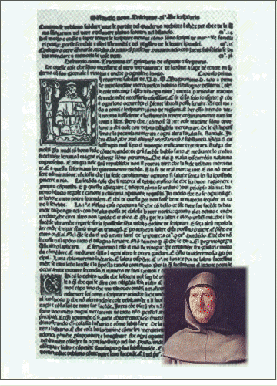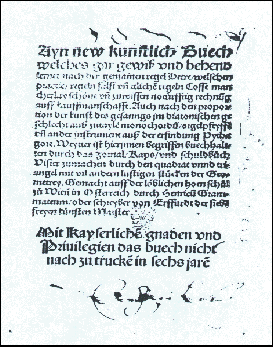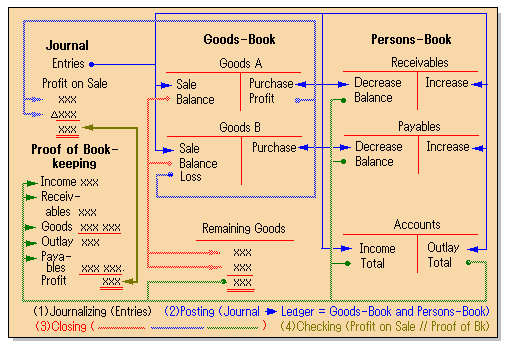
 Paciolo and his "Summa"
Paciolo and his "Summa"
 Abstract:
This article brings to light the neglected contribution of Grammateus,
the author of "Ayn New Kunstlich Buech (A New Skill Book)" which, although basically
a mathematics text, contained a section on bookkeeping in the style of Paciolo's "Summa".
His work is analyzed to prove the technical competence and the historical nature of the
bookkeeping system which he propounded.
Abstract:
This article brings to light the neglected contribution of Grammateus,
the author of "Ayn New Kunstlich Buech (A New Skill Book)" which, although basically
a mathematics text, contained a section on bookkeeping in the style of Paciolo's "Summa".
His work is analyzed to prove the technical competence and the historical nature of the
bookkeeping system which he propounded.

 Paciolo and his "Summa"
Paciolo and his "Summa"
 Some eight hundred years ago the seed of modern bookkeeping was sown in Florence, Italy.
Fragments dated 1211 of the account book of a Florentine banker present the earliest known
evidence of the double entry-system1).
From this time the art of bookkeeping began to bud and continued to grow in the fertile soil
of commercial practice in Italy. About three hundred years later the double entry concept
came to full fruition in Venice.
Some eight hundred years ago the seed of modern bookkeeping was sown in Florence, Italy.
Fragments dated 1211 of the account book of a Florentine banker present the earliest known
evidence of the double entry-system1).
From this time the art of bookkeeping began to bud and continued to grow in the fertile soil
of commercial practice in Italy. About three hundred years later the double entry concept
came to full fruition in Venice.
▼ Paciolo and his "Summa"
|
 In 1494 an Italian monk published a book on mathematics which included 36 chapters explaining
double entry bookkeeping. In his book, "Summa", Luca Paciolo wrote "we describe the
method employed in Venice"2).
In 1494 an Italian monk published a book on mathematics which included 36 chapters explaining
double entry bookkeeping. In his book, "Summa", Luca Paciolo wrote "we describe the
method employed in Venice"2).
 Paciolo thus made no claim to the invention of the
double entry system, but its inclusion in his book has resulted in his being generally
recognized as the the author of the first published double entry bookkeeping text.
Paciolo thus made no claim to the invention of the
double entry system, but its inclusion in his book has resulted in his being generally
recognized as the the author of the first published double entry bookkeeping text.
 Benedetto Cotrugli is believed to have written the first double entry bookkeeping book in 1458.
It and other hand written manuscripts seem to have circulated in the Italian city states
during the 15th century. Cotrugli's book was not published until 1573 so Paciolo may claim
the first published text. Hatfield wrote "it is seldom the case that a first book on a
subject has so dominated its literature as was the case with Paciolo's
De Computis et Scripturis"3).
Benedetto Cotrugli is believed to have written the first double entry bookkeeping book in 1458.
It and other hand written manuscripts seem to have circulated in the Italian city states
during the 15th century. Cotrugli's book was not published until 1573 so Paciolo may claim
the first published text. Hatfield wrote "it is seldom the case that a first book on a
subject has so dominated its literature as was the case with Paciolo's
De Computis et Scripturis"3).

 Grammateus and his "Ayn New Kunstlich Buech"
Grammateus and his "Ayn New Kunstlich Buech"
 In 1518, some twenty-four years after Paciolo had published his
book a German mathematician named Henricus Grammateus (Heinrich Schreiber in German)
4)
completed a book on mathematics at Vienna and published it at Nuremberg in 1521.
In 1518, some twenty-four years after Paciolo had published his
book a German mathematician named Henricus Grammateus (Heinrich Schreiber in German)
4)
completed a book on mathematics at Vienna and published it at Nuremberg in 1521.
▼ Ayn New Kunstlich Buech
|
 This book, "Any New Kunstlich Buech (A New Skill Book)" devoted a section to the subject of
bookkeeping. The first edition was neither paged nor divided into chapter. If it had been
paged, it would consist of 248 pages of which pages 187 to 216 are concerned with bookkeeping.
This book is recognized as the oldest German Text on bookkeeping and, following Paciolo,
the second oldest printed text in the world.
This book, "Any New Kunstlich Buech (A New Skill Book)" devoted a section to the subject of
bookkeeping. The first edition was neither paged nor divided into chapter. If it had been
paged, it would consist of 248 pages of which pages 187 to 216 are concerned with bookkeeping.
This book is recognized as the oldest German Text on bookkeeping and, following Paciolo,
the second oldest printed text in the world.
 Several historians have compared Paciolo's and Grammateus' texts to the detriment of
Grammateus.
Several historians have compared Paciolo's and Grammateus' texts to the detriment of
Grammateus.
 For example, J.R.Fogo wrote about Grammateus' book "...the part dealing with
bookkeeping is very brief, and so confused and bad that it proves the arithmetic-master's
knowledge to have been very perfunctory....it is extremely improbable that he himself knew
much about what he was professing to teach"
5).
B. Penndorf, a German bookkeeping historian, described "...his bookkeeping as neither single
or double; he has known Paciolo's work, but not understood. So we will perhaps have to reduce
the praise that Grammateus has hitherto received to the proper extent, as J.Row Fogo has
already done"6).
For example, J.R.Fogo wrote about Grammateus' book "...the part dealing with
bookkeeping is very brief, and so confused and bad that it proves the arithmetic-master's
knowledge to have been very perfunctory....it is extremely improbable that he himself knew
much about what he was professing to teach"
5).
B. Penndorf, a German bookkeeping historian, described "...his bookkeeping as neither single
or double; he has known Paciolo's work, but not understood. So we will perhaps have to reduce
the praise that Grammateus has hitherto received to the proper extent, as J.Row Fogo has
already done"6).
 These comments by Fogo and Penndorf are followed by other historians. The view that Grammateus
did not understand double entry bookkeeping is still widely held.
These comments by Fogo and Penndorf are followed by other historians. The view that Grammateus
did not understand double entry bookkeeping is still widely held.

 Grammateus' Bookkeeping System
Grammateus' Bookkeeping System
 The "Era of the Fuggers"7) is symbolic of the economic prosperity of Germany during the Middle Ages.
Bookkeeping is a method of accounting for capital and is closely related to economic
conditions8).
The "Era of the Fuggers"7) is symbolic of the economic prosperity of Germany during the Middle Ages.
Bookkeeping is a method of accounting for capital and is closely related to economic
conditions8).
 Judging from the economic sophistication that Southern Germany had attained during this
period, it seems doubtful that bookkeeping methods could have been as "underdeveloped" as the
above comments imply. On the contrary, the high level of economic activity should have
fostered a higher development of bookkeeping methods there than in other countries.
Judging from the economic sophistication that Southern Germany had attained during this
period, it seems doubtful that bookkeeping methods could have been as "underdeveloped" as the
above comments imply. On the contrary, the high level of economic activity should have
fostered a higher development of bookkeeping methods there than in other countries.
 Using this hypothesis, the author cannot accept completely the criticism that Grammateus
did not understand double entry bookkeeping. A review of his system in three respets: the
system of records used, the entry rules and closing procedure, leads to the conclusion that
Grammateus' method was based upon a double entry concept.
Using this hypothesis, the author cannot accept completely the criticism that Grammateus
did not understand double entry bookkeeping. A review of his system in three respets: the
system of records used, the entry rules and closing procedure, leads to the conclusion that
Grammateus' method was based upon a double entry concept.
 ▼FLOW-CHART of Bookkeeping by Grammateus ▼FLOW-CHART of Bookkeeping by Grammateus
|
 With respect to the "underdeveloped"
charge, he was an exponent of "periodic accounting" as opposed to the so called
"lot accounting", and there was a numerical connection between the journal and ledger.
These are evidences of a well developed system.
With respect to the "underdeveloped"
charge, he was an exponent of "periodic accounting" as opposed to the so called
"lot accounting", and there was a numerical connection between the journal and ledger.
These are evidences of a well developed system.
 The system propounded by Grammateus in his 1521 edition discloses the periodic accounting.
The process is indicatd by the use of remaining goods record and a proof of bookkeeping.
This and relating the journal to the ledgers with a numerical connection are approaches which
were not well defined in Paciolo's work.
The system propounded by Grammateus in his 1521 edition discloses the periodic accounting.
The process is indicatd by the use of remaining goods record and a proof of bookkeeping.
This and relating the journal to the ledgers with a numerical connection are approaches which
were not well defined in Paciolo's work.
 Simon Stevin has been given credit for introducing the annual settlement
(periodic accounting) and the numerical connection in his text of 1605 - 1608.
It is clear that Grammateus preceed Stevin in both of these concepts.
Simon Stevin has been given credit for introducing the annual settlement
(periodic accounting) and the numerical connection in his text of 1605 - 1608.
It is clear that Grammateus preceed Stevin in both of these concepts.
 In addition, he
explained the compound transaction as can be seen in the transaction journalization of the
7th of February on page 192. The introduction of the compound transaction has generally
been attributed to James Peele (1569).
In addition, he
explained the compound transaction as can be seen in the transaction journalization of the
7th of February on page 192. The introduction of the compound transaction has generally
been attributed to James Peele (1569).

 A Need to Account for Invested Capital
A Need to Account for Invested Capital
 Grammateus' contribution in emphasizing the periodic accounting method is particularly
notable.
Grammateus' contribution in emphasizing the periodic accounting method is particularly
notable.
 It is apparent that the lot acounting method (venture accounting) and the periodic
accounting method had co-existed in the general practices of double entry bookkeeping at the
beginning of the 16th century. The term "co-existed" is used since, passively, an author may
not be able to discern, in a simple manner, the shift from the "lot method" to the "periodic
method" as bookkeeping developed. Actively, an author may be able to recognize a homogeneous
conception within both methods, and this would lead him to seek for something other than mere
difference in method.
It is apparent that the lot acounting method (venture accounting) and the periodic
accounting method had co-existed in the general practices of double entry bookkeeping at the
beginning of the 16th century. The term "co-existed" is used since, passively, an author may
not be able to discern, in a simple manner, the shift from the "lot method" to the "periodic
method" as bookkeeping developed. Actively, an author may be able to recognize a homogeneous
conception within both methods, and this would lead him to seek for something other than mere
difference in method.
 "Guided by a conception of the kinds of events that will be relevant, the historian may
attempt to trace the origin and development of a particular idea or practice"
9). In this case the underlying
conception rests on the objective of bookkeeping.
"Guided by a conception of the kinds of events that will be relevant, the historian may
attempt to trace the origin and development of a particular idea or practice"
9). In this case the underlying
conception rests on the objective of bookkeeping.
 Simply, it was caused by a need to account
for invested capital. This capital is employed to seek profits and bookkeeping must follow
the activity. By itself, the amount of profit is meaningless and must be measured in relation
to a time cycle of capital movement. That is, profit (or loss) must be measured as a factor of
the efficiency of the use of capital as well as an absolute increase (or decrease) of
capital.
Simply, it was caused by a need to account
for invested capital. This capital is employed to seek profits and bookkeeping must follow
the activity. By itself, the amount of profit is meaningless and must be measured in relation
to a time cycle of capital movement. That is, profit (or loss) must be measured as a factor of
the efficiency of the use of capital as well as an absolute increase (or decrease) of
capital.
 To view the change from the lot method to the periodic method as simply a major event in
bookkeeping history emphasizes a change in format (or technique) rather than the more
fundamental function of bookkeeping to conform to social or economic change.
To view the change from the lot method to the periodic method as simply a major event in
bookkeeping history emphasizes a change in format (or technique) rather than the more
fundamental function of bookkeeping to conform to social or economic change.

 Importance of Periodic Accounting
Importance of Periodic Accounting
 When we recognize a homogeneous conception within both methods,
we may be able to discern the
difference between bookkeeping and accounting, not as a difference between form and
procedure, but as a difference between the functions of bookkeeping and accounting as
a capital calculation at different social stages.
When we recognize a homogeneous conception within both methods,
we may be able to discern the
difference between bookkeeping and accounting, not as a difference between form and
procedure, but as a difference between the functions of bookkeeping and accounting as
a capital calculation at different social stages.
 To illustrate that periodic accounting considering the absolute amount
and the time cycle for invested capital must have been of interest to merchants, the following
algebraic problem was posed by Grammateus:
To illustrate that periodic accounting considering the absolute amount
and the time cycle for invested capital must have been of interest to merchants, the following
algebraic problem was posed by Grammateus:
|
 Grammateus maintained that bookkeeping is, by its very nature, always periodic.
It was only a short interval between the publication of Paciolo's work and the publication
of his own text. However, during that interval he recognized a new importance of the
periodic method and by his illustrations and explanations gave us a new light to see the
history of bookkeeping and accounting.
Grammateus maintained that bookkeeping is, by its very nature, always periodic.
It was only a short interval between the publication of Paciolo's work and the publication
of his own text. However, during that interval he recognized a new importance of the
periodic method and by his illustrations and explanations gave us a new light to see the
history of bookkeeping and accounting.
 Grammateus has often been esteemed as the first
German author to write on bookkeeping and the author of the text published second only to
Paciolo's in the world. However, it has not been until recent times that he has been
credited with being the first author to recognize and explain the increased importance of
the use of periodic accounting; a concept that still governs much of accounting theory and
practice today.
Grammateus has often been esteemed as the first
German author to write on bookkeeping and the author of the text published second only to
Paciolo's in the world. However, it has not been until recent times that he has been
credited with being the first author to recognize and explain the increased importance of
the use of periodic accounting; a concept that still governs much of accounting theory and
practice today.